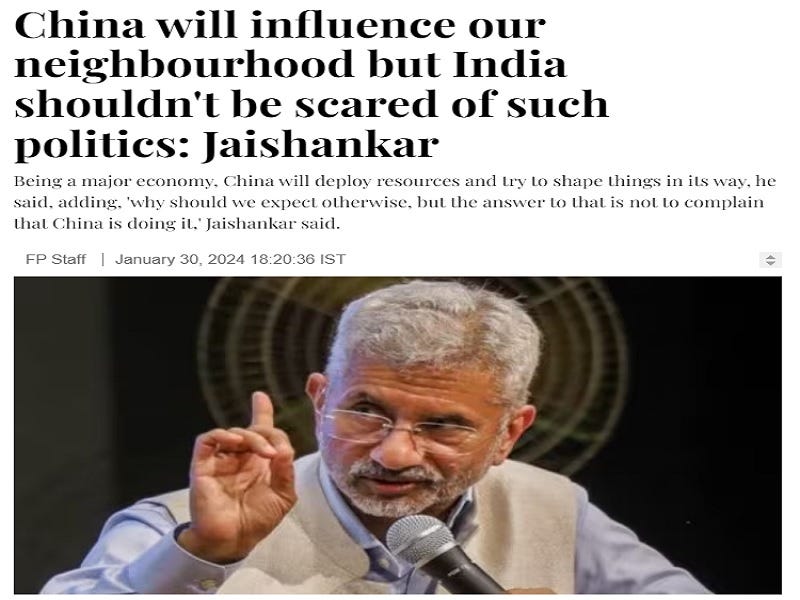The masterful interplay between nationalism and internationalism, particularly with respect to balancing complex domestic and international affairs, has become the defining feature of the “India Way”. This model, which manifests itself at home through vibrant socio-political pluralism and abroad via its multi-alignment between key players, can serve to inspire the rest of the Global South that looks to India for leadership in the New Cold War.
External Affairs Minister (EAM) Dr. Subrahmanyam Jaishankar elaborated on his country’s attitude towards competition with China by reassuring everyone that it’s a natural process, nobody should fear it, and this should inspire India to step up instead of complain. Too many countries misportray competition as something artificial, but the Neo-Realist paradigm (which becomes Hyper-Realist whenever one’s interests are explicitly articulated like EAM Jaishankar regularly does) accepts this as inevitable.
Only those countries and their representatives who publicly express such views in particular can account for whether they’re deliberately trying to deceive the public as part of an infowar campaign against their competitors or if they truly see the world according to a different International Relations paradigm. In any case, the argument can compellingly be made like EAM Jaishankar just concisely did that nobody should expect anything otherwise since countries will always try to advance their interests in all spheres.
This insight segues into his second point about why nobody should fear this process. While it’s true that uncontrollable competition can lead to hot conflicts by miscalculation, especially if the two parties are embroiled in an escalating security dilemma, the Hyper-Realist paradigm of explicitly articulating each side’s interests can help responsibly manage this for the greater good. More competition can lead to more innovation, which in turn can translate into more tangible benefits for all those involved.
And finally, complaining about the existence of regional competition like many countries’ representatives are prone to do signals either delusion or weakness, the first being the case if they’re truly under the spell of other International Relations paradigms and the second if they aren’t but can’t actually compete. Both are bad for a country’s image, and the argument can be made that it’s better to talk tough in those scenarios than to give off these vibes, but few representatives have the self-consciousness to see that.
By contrast, India is a self-confident civilization-state whose global influence has been surging throughout the past two years since the start of Russia’s special operation due to the adroitness of its diplomacy, which is practiced by EAM Jaishankar but according to Prime Minister Narendra Modi’s vision. The masterful interplay between nationalism and internationalism, particularly with respect to balancing complex domestic and international affairs, has become the defining feature of the “India Way”.
This model, which manifests itself at home through vibrant socio-political pluralism and abroad via its multi-alignment between key players, can serve to inspire the rest of the Global South that looks to India for leadership in the New Cold War as the de facto head of the New Non-Aligned Movement (Neo-NAM). In this context, each of India’s medium- and smaller-sized partners can maximize the benefits that they stand to reap by embracing competition instead of denying it, and then responsibly managing it.
To this end, they should acknowledge that International Relations is in a state of tri-multipolarity as explained here whereby the primary poles are the US-led West’s Golden Billion, the Sino-Russo Entente, and the informally Indian-led Global South, whose interplay is described in the first hyperlinked analysis. Upon doing so, they can then better appreciate their collective bargaining strength as members of the Global South/Neo-NAM, after which they can decide how best to balance between the other two poles.
The cultivation of friendly, gentle, and non-hostile competition can lead to those two and emerging poles within the Global South like India offering countries the most favorable terms possible on whatever it may be (e.g. security, tech, trade, etc.) in order to beat out the others for clinching that deal. The greater array of choice that this approach towards competition provides will reduce costs, increase benefits, and enable countries to flexibly negotiate the best possible terms from their partners.
For that to happen, they must first follow EAM Jaishankar’s advice of recognizing competition as a natural process, downplaying the false fears that some have of it, and then deciding to compete as well, after which they can then formulate their negotiating tactics according to the tri-multipolarity paradigm. The way in which India competes with China might therefore become the standard all across the Global South, which can lead to more responsible management of these processes along with better benefits.





India is not at alone the driver for a multipolar world. It is in this prosject together with Russia and China. So to make it the leading model for the world, is not constructive.